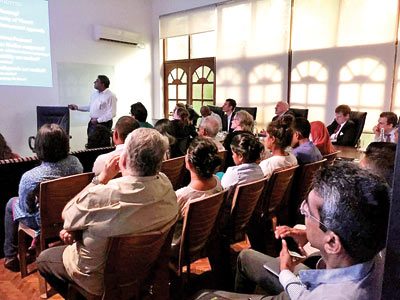Government’s Megapolis Plan needs overhaul

Prof. Amal Kumarage makes his presentation
The Sri Lankan government’s proposed US$12 billion investment for improving transport as part of its Megapolis plan lacks technical and procedural cohesion, according to a respected expert in transport and logistics management. Amal Kumarage, senior professor in the Department of Transport and Logistics Management at the University of Moratuwa and a Fellow of the Chartered Institute of Logistics and Transport, said this week that transport is a critical catalyst for improving urban competitiveness and improving the quality of life and services. He added that the major threats to developing a sustainable transportation system are the popularity of ad hoc led proposals, the vulnerability to supplier driven projects and standalone projects being favoured over integrated plans. Speaking at a seminar organized by research agency Verite Research in Colombo, Prof. Kumarage said proper transportation planning is essential in addressing intense mobility issues in the Western Province and key to unlocking economic development.
The Megapolis plan calls for a total investment of Rs.1,452 billion with 63 per cent of that investment going to roads. He said this is the wrong direction as more roads lead to more traffic. Instead, existing roads need to be used for the movement of people. According to a study conducted by the University of Moratuwa on a review of a Japanese International Cooperation Agency (JICA) funded transport plan submitted in 2014, Prof. Kumarage said public transport is disorganized in providing quality service. There is a heavy promotion of private vehicle ownership even though not everyone can afford their own vehicles. Recently, he added that there has been a push from the public for improving urban livability and competitiveness. The University of Moratuwa study is pushing for incremental interventions in 2020, 2025 and 2035 with minimum cost to the economy as government borrowing is limited.
By 2020, the study calls for improving the bus system with a good railway system to supplement it. In 2025, the study outlines the realization of six radial railway network developments. In the year 2035, the study calls for a multi modal transport network through bus, railway, transit and road. The study had budgeted an investment in the bus system of Rs.343 billion, railway Rs.497 billion, rapid transit Rs.118.3 billion and urban roads Rs.388 billion amongst others. Prof. Kumarage said about half of the total funding of Rs.1,623 billion can be found in the private sector. The government’s plan calls for a far lower investment of Rs.4.2 billion in the bus system and Rs.17.7 billion in the railway system while the majority goes for the construction of more roads. In the medium term, the Megapolis plan calls for nearly 200 km of urban expressways. Prof. Kumarage said the private sector does not invest in roads. In fact, revenue from the tolls are not (even) enough to pay the staff who manage the expressways.


